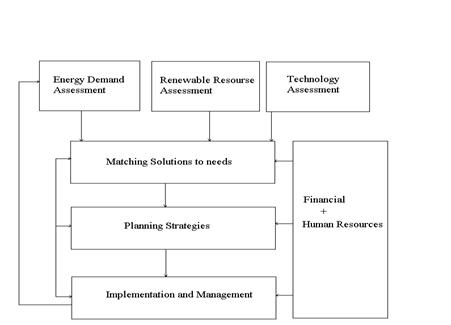Conclusions
Kolar depends mainly on non-commercial forms of energy. Non commercial energy constitutes 84%, met mainly by sources like firewood, agricultural residues and cowdung, while commercial energy share is 16%, met mainly by electricity, oil etc. Based on this investigation of biomass resource availability and demand, Kolar can be categorised as bioresource deficit region. The present inefficient fuel consumption could be brought down by the usage of fuel-efficient stoves.
Framework of the integrated energy plan proposed for a district is shown schemetically below (Fig.3).
 Fig. 3: Framework of Regional Energy Planning and Management
Fig. 3: Framework of Regional Energy Planning and Management
Availability of animal residues for biogas generation gives a viable alternative for cooking, lighting fuel and a useful fertiliser. However to support the present livestock population fodder from agricultural residues is insufficient in these Taluks. Various alternatives such as fuel-efficient stoves, biogas, energy plantations are proposed for improved utilisation of bio resources and to enhance bioresource stock in a region with techno economic analyses.
Renewables such as solar has good potential in the area, but the spread is hampered by economic constraint. Small-scale use of wind turbine can be promoted for water lifting and such other purposes. Solar energy is available and can be used for water heating and water lifting need effectively provided it is subsidised to affordable cost. Integrated approach in energy use involves diversity in energy use, keeping environmental and social criterions. |